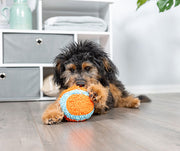Flying With A Pet

Airline travel is a safe, convenient way to travel. It is among the fastest and most efficient ways to travel. However, flying can sometimes not be the easiest way to travel. From security checks to baggage claims, airline travel can be a complex way to travel. Add in flying with a pet and things get even more complex.
If you plan on flying with a pet, you should take the proper steps to make the trip easy for both you and your pet. Air travel can cause a lot of anxiety for both of you. Here are seven travel tips that can ease the process and make the experience more enjoyable for both you and your pet.
Acclimate Your Pet to the Carrier: Give your pet time to become familiar with their plastic kennel before the trip. Place treats, toys, or bedding inside to create a positive association. This can help reduce anxiety during the journey.
Check Airline Policies: Airlines have varying pet travel policies. Ensure you are aware of and comply with all their requirements. This includes plastic kennel dimensions, documentation, and any specific rules for in-cabin or cargo hold travel. The Petmate Sky Kennel is an excellent choice for cargo hold as it meets most air travel requirements.
Pack Essentials: Bring a travel kit for your pet, including their regular food, water bowl, a leash, waste bags, travel accessories, and any necessary medications.
Visit the Restroom Before Security: Take your pet for a bathroom break just before entering the airport security area. Most airports have designated pet relief areas, so plan accordingly to avoid any accidents during the journey.
Stay Calm and Positive: Pets can pick up on their owner’s emotions. Stay calm and composed, and speak to your pet in a soothing voice. Positive reinforcement can help reassure them during the various stages of travel.
Research Pet-Friendly Hotels: If your journey includes overnight stays, ensure that your accommodations are pet-friendly. Research hotels or lodgings that not only allow pets but also provide amenities for their comfort.
Microchip and Updated Identification: Ensure your pet has a microchip with updated information before flying with a pet. Additionally, have a recent photo and clear identification on the carrier. In the unlikely event of separation, this will aid in a swift reunion.
Monitor Weather Conditions: Be aware of the weather conditions at your departure and arrival locations. Extreme temperatures can affect your pet in the cargo hold. Consider this when scheduling flights and make adjustments as needed.
Post-Flight Check: After landing, take some time to check on your pet’s well-being. Ensure they are comfortable and offer water and a familiar treat. This post-flight care is crucial to help your pet readjust to their new surroundings.
Prepare for Security Checks: Be aware of the security check process for flying with a pet. You may need to remove your pet from the carrier during security screening, so practice this at home to familiarize yourself and your pet with the process.
Remember that every pet is unique, and when flying with a pet their reactions to travel can vary. Tailor your approach based on your pet’s individual needs and consult with your veterinarian for personalized advice. Your detailed preparation and consideration will contribute to a smoother and more comfortable travel experience for both you and your pet.
Previous article

Next article

Related posts
View all-

What Can You Use Instead of Cat Litter?
Traditional cat litter is convenient, but it’s not the only option. Many cat owners look for alternatives to reduce waste, save money, or avoid chemicals found in clay-based kitty litter. Some options offer better odor control, while others are more eco-friendly or gentler on a cat’s paws.
Read Article -

How to Keep My Backyard Smelling Fresh
A clean backyard should smell fresh, unlike pet waste, smoke, or mold. Bad smells can linger, especially when dog poop, urine, or food scraps attract flies and bacteria. If your yard has a foul odor, it's time to take action. The first step is cleaning up pet feces, trash, or rotting food. A garden hose can wash away dirt and urine from artificial turf, patios, and decks. To neutralize odor, Use baking soda, white vinegar, and essential oils.
Read Article -

What Supplies Do First-Time Cat Owners Need?
Bringing home a new cat is exciting, but making them feel safe and comfortable takes more than love. First-time cat owners must prepare with the right supplies to ensure a smooth transition. From a litter box to cat food and a warm bed, having the basics ready can help your new kitty settle in faster. This guide covers everything a new cat owner needs to make their new pet feel at home.
Read Article



